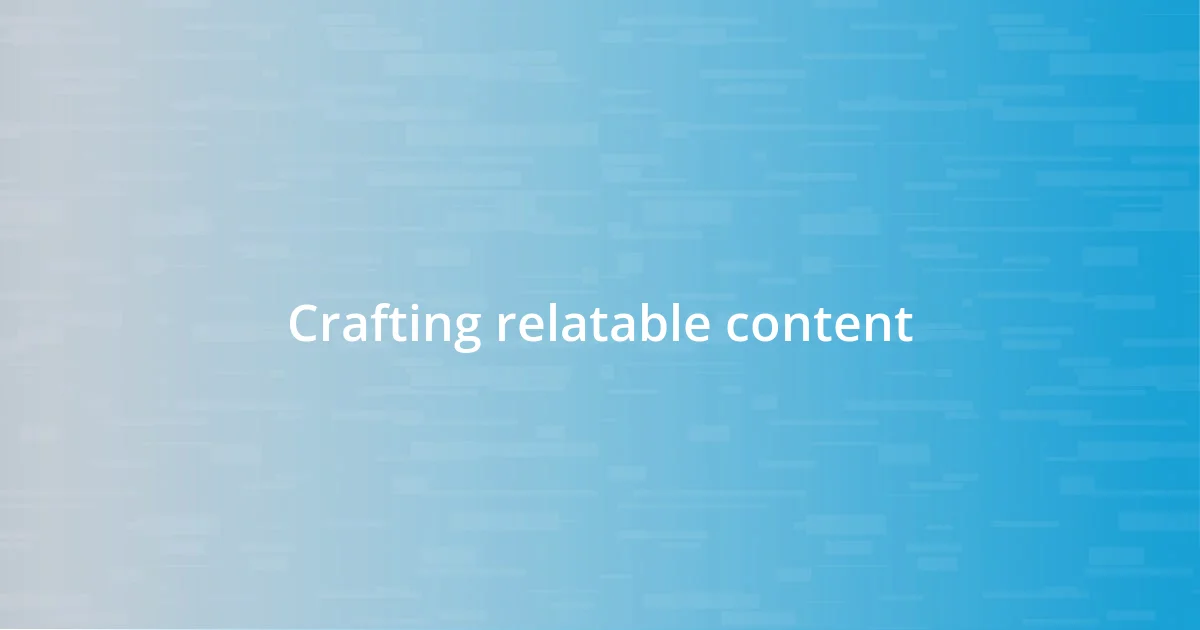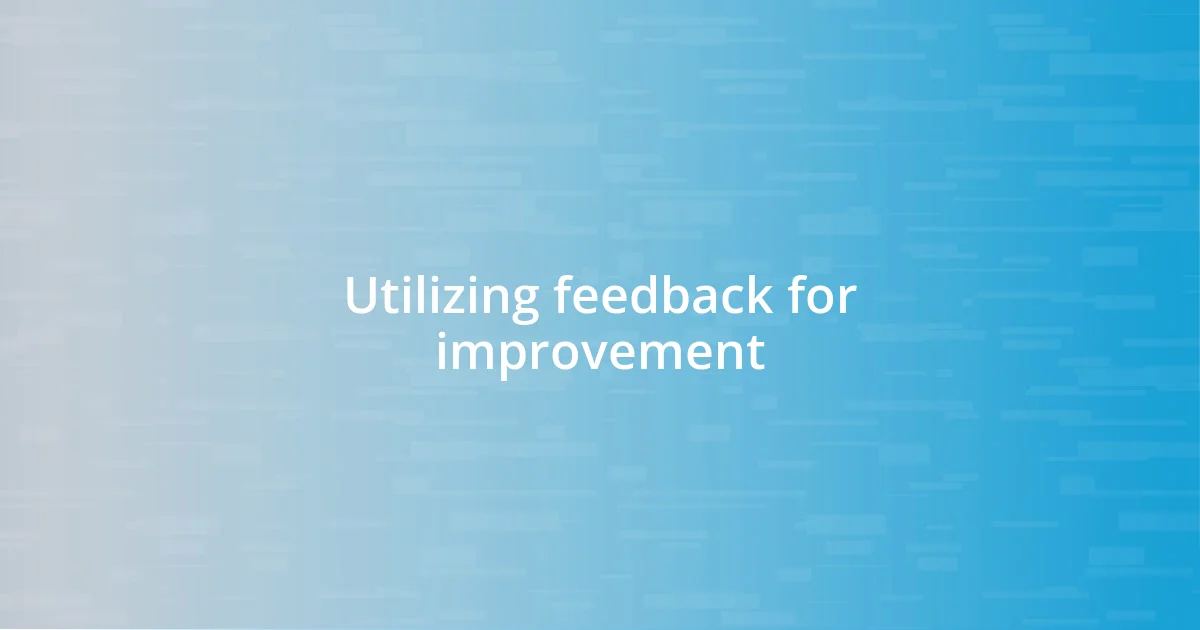Key takeaways:
- Understanding audience needs requires active listening and creating a safe environment for open dialogue to foster genuine connections.
- Building authentic relationships involves vulnerability, trust, and engaging the audience through personal stories and open-ended questions.
- Utilizing feedback effectively leads to continuous improvement, as it helps tailor content to audience preferences and enhances overall engagement.

Understanding audience needs
Understanding audience needs begins with actively listening to their feedback. I remember attending a workshop where participants shared their struggles and objectives openly. It dawned on me just how vital it is to create an environment where the audience feels safe to express themselves—after all, how can we truly serve them if we don’t hear their voices?
Sometimes, I’ll find myself contemplating the emotions behind my audience’s needs. Why do they seek connection? What fears or aspirations drive their engagement? I vividly recall a moment during a presentation when I paused to ask the audience what they hoped to gain from the discussion. Their heartfelt responses highlighted the importance of not just presenting information but building a dialogue founded on mutual understanding.
Moreover, tapping into demographic insights shapes our approach significantly. When I tailored content based on the specific backgrounds and interests of my audience, the response was overwhelmingly positive. It made me realize that understanding audience needs isn’t just about meeting expectations; it’s about forging genuine connections that resonate on a personal level. Wouldn’t you agree that these connections are what make communication impactful?

Building authentic relationships
Building authentic relationships requires more than just skin-deep interactions; it demands vulnerability and trust. I recall a project where I decided to share my own challenges with the audience, opening up a dialogue that felt less like a lecture and more like a conversation among friends. The atmosphere shifted dramatically; suddenly, I could see nods of understanding and smiles of encouragement, revealing the power of shared experiences. When we let our guard down, it invites others to do the same, creating a ripple effect of authenticity.
- One effective way to build these relationships is by asking open-ended questions that encourage deeper reflection.
- Sharing personal stories—both successes and failures—makes me relatable and allows the audience to see the human side behind the content.
- I often follow up with audience members after events, inviting their thoughts and feedback, which strengthens our bond.
- Acknowledging individual contributions during discussions not only validates participants but also fosters a sense of belonging.

Crafting relatable content
Crafting content that resonates is an art. Personally, I find that using relatable language makes a significant difference. For instance, during a recent webinar, instead of relying on jargon, I chose to describe a complex concept using a story from my own life. The moment I shared my experience, I noticed the audience lean in, as if to say, “Yes, I understand that feeling.” It’s fascinating how familiarity breeds connection—so why not embrace it?
I also believe that humor can be a powerful tool in crafting relatable content. In my experience, a lighthearted joke about a common struggle can instantly break the ice and make the audience feel at ease. Once, I used a funny mishap I had when trying to implement a new technology at work. The laughter that erupted not only created a shared moment but also fostered a sense of community. Through these small connections, I aim to remind my audience that they’re not alone in their challenges.
Lastly, visually engaging elements can enhance relatability. I’ve found that incorporating images or memes—especially those tied to relatable situations—helps create a bond with the audience. It’s as if we are having a conversation and sharing inside jokes. When attendees react to a visual representation of their own experiences, it deepens their engagement. So why not think of your audience’s emotions and shared moments when crafting content? It could be the key to making an impact.
| Crafting Relatable Content Strategies | Personal Insights |
|---|---|
| Using Familiar Language | Sharing personal stories helps the audience connect emotionally. |
| Incorporating Humor | A well-placed joke breaks the ice and fosters community. |
| Utilizing Visual Elements | Images that reflect shared experiences enhance engagement. |

Engaging through storytelling techniques
Engaging audiences through storytelling techniques is like weaving a tapestry of shared experiences. I once shared a pivotal moment from my childhood—getting lost in a new city. As I recounted the mix of fear and excitement, I could see my audience reflecting on their own similar experiences. Isn’t it amazing how a simple story can ignite empathy and connection?
Another powerful storytelling technique is the use of vivid imagery that transports the audience to a different place or time. I vividly remember recounting a particularly vibrant summer festival in my hometown. I painted a picture of colorful stalls, laughter, and the scent of popcorn in the air. I could feel the audience’s smiles grow as they allowed themselves to imagine being there too. This sensory approach creates a bridge to our collective memories, making the message far more memorable.
Lastly, incorporating conflict and resolution into stories can make the content more dynamic and relatable. There was a time when I faced a major setback in my career, but I chose to turn it into a learning opportunity. I shared the highs and lows of that journey, emphasizing how overcoming challenges often leads to personal growth. By inviting the audience to cheer for my triumph, I found myself cheering for their struggles too. A story like this begs the question—how do we turn our own obstacles into stepping stones? It’s this exploration of shared adversities that helps forge deeper connections with the audience.

Utilizing feedback for improvement
Utilizing feedback is essential for continuous improvement and growth. I’ve experienced firsthand how constructive criticism can elevate the quality of my content. During a recent series of workshops, I received mixed reviews on a presentation. Instead of brushing off the less favorable comments, I dug deeper. I reached out to participants and engaged in meaningful conversations about what resonated and what fell flat. Through this dialogue, I gained invaluable insights that reshaped my approach and ultimately made the next presentation much stronger.
In my journey, I’ve found that embracing feedback, even when it stings, can be incredibly liberating. I vividly recall a session where an audience member pointed out that I hadn’t addressed a common concern they had. Initially, it felt disheartening, but then I realized it was a golden opportunity for growth. I took these remarks to heart and used them to create follow-up content that directly addressed those concerns. It’s funny how vulnerability can transform into strength; inviting criticism not only improved my work but also signaled to my audience that their opinions genuinely matter.
Moreover, I make it a point to regularly check in with my audience through surveys or informal chats. These interactions often reveal surprising insights. Once, after a presentation, one participant remarked that they loved the way I structured my stories, but wished for more actionable takeaways. This sparked a re-evaluation of my content delivery. Now, I ensure that every presentation bridges insights with clear next steps. By treating feedback as a collaborative dialogue, I’m not just enhancing my content—I’m creating a richer experience that benefits everyone involved. How about you? Have you tapped into the power of feedback to refine your own work?

Measuring audience connection success
One of the most effective ways I measure audience connection success is through direct engagement during and after my presentations. I recall a time I wrapped up a talk about overcoming fear in public speaking, and instead of the usual Q&A session, I invited the audience to share their own experiences. The energy in the room shifted from passive listening to active participation, revealing that they felt seen and heard. Isn’t it fascinating how real-time interaction can give such a clear indication of connection?
Another metric I rely on is observing body language and reactions during my sessions. I remember presenting at a conference where I introduced a new concept. Initially, the audience seemed puzzled, which was noticeable in their expressions and lack of eye contact. By adapting my approach and seeking clarification through questions, I could see them lean in and engage more—those subtle shifts really signaled that we were bridging the gap together. Have you ever noticed how powerful those non-verbal cues can be?
Additionally, post-event surveys and feedback forms have proven invaluable for gauging connection success. In one instance, after receiving a wealth of responses that pointed out the relatability of my anecdotes, I noticed a consistent theme: people appreciated authenticity. This insight inspired me to share more behind-the-scenes moments in future presentations. It’s interesting how the data we collect can validate our experiences and guide us towards a deeper resonance with our audience. How do you approach gathering feedback to enhance your own connection with listeners?

Adapting strategies for future growth
As I think about adapting strategies for future growth, one experience stands out. I launched a new workshop format based on an audience’s desire for more interactive sessions. The first time I implemented this, I noticed participants were not only more engaged, but they also started sharing their insights, which enriched the overall experience. How thrilling is it to witness growth sparked by simply listening to what your audience craves? I felt a sense of accomplishment knowing that their input directly shaped a better learning environment.
Another pivotal moment was when I started analyzing the trends in participant feedback over time. I remember sifting through responses and identifying a consistent interest in digital tools for content creation. That realization prompted me to incorporate these tools into my workshops, transforming my teaching approach and expanding my audience base. I can’t stress enough how often our audience can guide our learning paths. Isn’t it remarkable how paying attention can lead to unexpected avenues for growth?
Looking ahead, I’ve decided to embrace a more iterative approach. Instead of launching new content with a fixed mindset, I’m now experimenting in smaller increments. For example, I recently tried out a new topic in a pilot workshop and gathered immediate feedback. The key takeaway was crystal clear: the audience loved it but wanted to dive deeper into specific areas. I left that session buzzing with ideas for future content. Have you considered how a flexible, experimental mindset can enhance your connection with your audience? It might just be the game changer you’re looking for.
















